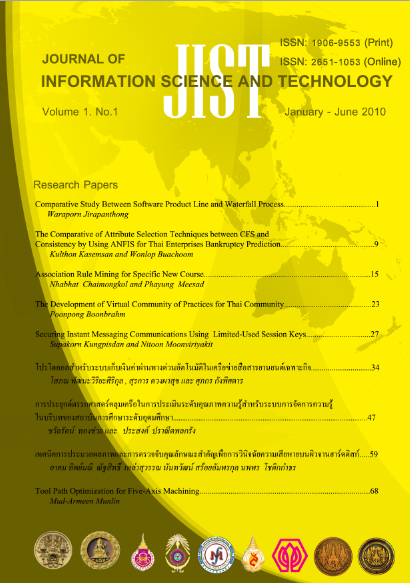Comparative Study Between Software Product Line and Waterfall Process
Main Article Content
Abstract
- Software product line has been recognised as an important paradigm for software systems engineering. In the last years, a large number of methodologies and approaches have been proposed to support the development of software systems based on product line development. However, its context leads difficulties to software product line engineering in practical. It has been quested whether software product line-based approach is more productive and flexible than traditional software development model i.e. waterfall model. This research thus examines the qualitative and quantitative aspects of software development which applies software product line and waterfall. The paper presents the study on empirical projects based on software product line and waterfall processes. In particular, we conducted the survey and interview to capture the satisfaction of stakeholders and measured the effort spent during software development and maintenance.
Article Details
This work is licensed under a Creative Commons Attribution-NonCommercial-NoDerivatives 4.0 International License.
I/we certify that I/we have participated sufficiently in the intellectual content, conception and design of this work or the analysis and interpretation of the data (when applicable), as well as the writing of the manuscript, to take public responsibility for it and have agreed to have my/our name listed as a contributor. I/we believe the manuscript represents valid work. Neither this manuscript nor one with substantially similar content under my/our authorship has been published or is being considered for publication elsewhere, except as described in the covering letter. I/we certify that all the data collected during the study is presented in this manuscript and no data from the study has been or will be published separately. I/we attest that, if requested by the editors, I/we will provide the data/information or will cooperate fully in obtaining and providing the data/information on which the manuscript is based, for examination by the editors or their assignees. Financial interests, direct or indirect, that exist or may be perceived to exist for individual contributors in connection with the content of this paper have been disclosed in the cover letter. Sources of outside support of the project are named in the cover letter.
I/We hereby transfer(s), assign(s), or otherwise convey(s) all copyright ownership, including any and all rights incidental thereto, exclusively to the Journal, in the event that such work is published by the Journal. The Journal shall own the work, including 1) copyright; 2) the right to grant permission to republish the article in whole or in part, with or without fee; 3) the right to produce preprints or reprints and translate into languages other than English for sale or free distribution; and 4) the right to republish the work in a collection of articles in any other mechanical or electronic format.
We give the rights to the corresponding author to make necessary changes as per the request of the journal, do the rest of the correspondence on our behalf and he/she will act as the guarantor for the manuscript on our behalf.
All persons who have made substantial contributions to the work reported in the manuscript, but who are not contributors, are named in the Acknowledgment and have given me/us their written permission to be named. If I/we do not include an Acknowledgment that means I/we have not received substantial contributions from non-contributors and no contributor has been omitted.
References
2. Bayer, J., O. Flege, P. Knauber, R. Laqua, D. Muthig, K. Schmid, T. Widen, and J.-M. DeBaud. 1999. PuLSE: A methodology to develop software product lines. Pages 122-131. the Fifth ACM SIGSOFT Symposium on Software Reusability (SSR'99), Los Angeles, CA, USA.
3. Boehm, B. 1991. Software Risk Management: Principles and Practices. IEEE Software, no.pp. 32-41, January.
4. Clements, P., and L. Northrop. 2004. A Framework for Software Product Lines Practice. https://www.sei.cmu.edu/productlines/framework.html
5. Fenton, Norman E.. 1991. Software Metrics: A Rigorous Approach. Chapman & Hall, Ltd., London, UK.
6. Griss, M. L., J. Favaro, and M. d. Alessandro. 1998. Integrating feature modeling with the RSEB. Pages 76-85 in P. Devanbu and J. Poulin, eds. the 5th International Conference on Software Reuse. IEEE Computer Society Press.
7. Jirapanthong, W. 2008. An Approach to Software Artefact Specification for Supporting Product Line Systems. the 2008 International Conference on Software Engineering Research and Practice (SERP’08), Las Vegas, Nevada, USA, 2008.
8. Jirapanthong, W., and A. Zisman. 2009. XTraQue: traceability for product line systems. Software and System Modeling 8(1): 117-144 (2009).
9. Kang, K., S. Cohen, J. Hess, W. Novak, and A. Peterson. 1990. Feature-Oriented Domain Analysis (FODA) Feasibility Study. Software Engineering Institute, Carnegie Mellon University, Pittsburgh, PA.
10. Kang, K. C., S. Kim, J. Lee, K. Kim, E. Shin, and M. Huh. 1998. FORM: a feature-oriented reuse method with domain-specific architectures. Annals of Software Engineering 5: 143-168.
11. Linden, F. v. d., J. Bosch, E. Kamsties, K. K¨ans¨al¨a, and H. Obbink. 2004. Software Product Family Evaluation. Pages 110-129. the Third International Software Product Line Conference, SPLC 2004. Springer Boston, MA, USA.
12. Mills, Everald E. 1998. Software Metrics. SEI Curriculum Module SEI-CM-12-1.1, December.
13. Sharpe, J.L., and J. W. Cangussu. 2005. A productivity metric based on statistical pattern recognition. Computer Software and Applications Conference, 29th Annual International, 26-28 July.
14. Weiss, D. 1995. Software Synthesis: The FAST Process. the International Conference on Computing in High


